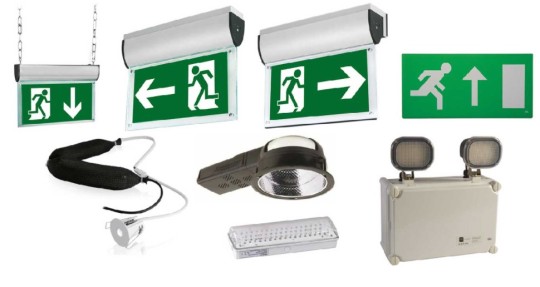Don't wanna be here? Send us removal request.
Photo

Will Your Fire Alarm Work As Expected?
Fire alarms are integral to safety measures in residential and commercial establishments. However, you can’t just have them installed and forget about them. Routine inspection and testing needs to be carried out to ensure that the fire alarm system is operating as intended on a quarterly basis, and that your establishment remains compliant with regulations such as Ireland’s Fire Services Acts 1981 & 2003. Let's delve into what the process entails.
What is Assessed During Fire Alarm System Inspections?
The different devices that the alarm system is composed of are looked into. These include:
Initiating devices
Here the focus is on the components needed to activate the fire alarm. They can be manual (such as buttons, pull stations and break glass stations) – and these are typically installed where the building’s occupants can access them in the event of an emergency; or automatic, which range from flame and smoke detectors, to new innovations like camera systems using artificial intelligence and video-based fire detection.
Notification devices
They are the devices that alert the building’s occupants of the fire, usually by sound or visual means, like the siren, bell or horn systems that work with a strobe or a flashing red light.
The fire alarm panel
This is the part that monitors the input from the initiating devices and the output from the notification devices, while ensuring that the integrity of the system is maintained for accurate information to be relayed.
Building safety interfaces
What’s the condition of the interfaces in the building that help the people to evacuate during a fire? This cuts across the board, from emergency lighting to ventilation systems.
The sensitivity of the system is also inspected, to ensure that it is within the operating parameters of the manufacturer. Other components that should be assessed include the power supply to the alarm system – both the primary source and the backup, to ensure that you will still receive the warnings in the event of a simultaneous fire breakout and power failure.
Types Of Fire Alarm Inspection Tests
● Acceptance Commissioning test
Carried out immediately after the installation of the alarm system, this test is required to ensure that all components are working. It’s typically done once after setup, but is also recommended before the premises gets occupied, and after renovations have been carried out in the building.
● Quarterly Maintenance test
This is a routine test where the technicians come in to assess the different components of the alarm system to ensure that they are working properly. They can be handled by the same company that handled the installation, such as with the certified Service Maintenance contract agreements from AMSL. For buildings where there are less than 20 devices combined, bi-annually maintenance is acceptable. Quarterly certification of maintenance will be provided by AMSL Group for contracted customers.
● Annual test
This is a routine test which will include Bell/Sounder testing to ensure the building will achieve the required decibel levels as laid out in the current standards and codes of practice. Annual certification of maintenance will be provided by AMSL Group for contracted customers.
where the technicians come in to assess the different components of the alarm system to ensure that they are working properly. They can be handled by the same company that handled the installation, such as with the certified Service Maintenance contract agreements from AMSL.
● Sensitivity Test
The test is done within a year after the fire alarm system is installed, with the main focus being ensuring that the initiating devices get activated within the ranges stipulated by the manufacturer. The personnel carrying out the test use metering devices and a heat element or aerosol smoke to trigger the activation, assessing whether this occurs within the manufacturer's limits. The readings from the metering device are compared with the ranges and ratings that are stated by the manufacturer for that system.
Preparing For The Alarm Inspection
After scheduling the inspection, you will need to inform your monitoring agency that there will be a test being carried out, as well as the timings involved. This is because they will still receive the alerts, but you don’t want them responding and sending over the emergency teams. They will still log the signals they receive, but you will avoid inconveniencing them.
You may also want to weigh what approach will be best when the notification devices are being inspected. Will they be tested simultaneously with the other component parts, and will it be during normal working hours? With the sirens, bells, horns and strobes going off, you want to schedule this at a time that will be least alarming for the occupants of the building. The flexible booking with AMSL allows you to schedule the test for the time that will be most convenient for your home or business premises
A Device Fails the Test – What next?
Firstly, the technicians carrying out the test will notify you, with a detailed report of the devices that have failed. After this, corrective measures can be taken.
If it’s just a few devices that have failed the test – and if the technicians sent to the premises have the replacements needed at hand, then you can simply have them installed immediately. The new component will then be tested to ensure that it works.
With multiple device failure and where lots of equipment will have to be replaced, then you will get a report and quotation, and you can then make arrangements to have the issue resolved.
To be clear, the technician is only required to notify you which devices have failed the testing process. It will then be up to you, the owner, to decide when to take up the next corrective measures. However, when dealing with a professional service, you should be able to smoothly make arrangements for this from the same company.
1 note
·
View note
Photo

Beyond 2021: Changing Trends In Wealth Management
Client demographics are evolving. Big tech has contributed to the growth of a well-informed generation, changing the Dublin wealth management ecosystem. With a more demanding client segment and tech-savvy investors, wealth management firms are enhancing their capabilities quickly to seize the moment. Let’s look at these trends and how they affect the product offering:
● Reports with a digital experience
Clients want fast access to their portfolio reports, in an easily digestible format. It’s no longer just about providing a digital version of the conventional paper-based reports. Wealth management Dublin firms are now focusing on intuitive and customised interfaces that clients can engage with to access dynamic reports.
● IoT and personalised advice
Wealth management is getting hyper personalised. Data analytics technology currently available already enables the firms to leverage on their customer data to get insights that are in line with each individual. As the trend moves to automated portfolio management, IoT devices will collect real-time data with insight into the clients' lifestyle, such as saving and spending habits. Analysing this information then shows the risk tolerance of the client, making onboarding smoother.
● Debiasing in active funds
Investment decisions based on intuition can have occasional successes, but the drawback – should it not pan out as expected, can lead to heavy losses. This is one of the factors that has contributed to reduced profit margins of actively managed funds, turning clients away to passive index funds. However, machine learning is increasingly being adopted, with the debiasing techniques involving loads of data being crunched down to show if the decisions being made are driven by emotions, which then trigger alerts. By changing cognitive biases and setting up corrective measures, wealth management firms are well-poised to create winning strategies that go for the long term.
● Impact investing
With more investors embracing sustainable investing, there is increased asset allocation in line with the clients' ESG (Environmental, Social Governance) requirements. Wealth managers providing these strategic investment opportunities have the competitive edge, securing a long-term presence in the niche.
● Gamification
No, managing your portfolio is not a game. Here the focus is simply on the tools used to engage clients, especially the millennials who are forming an increasingly larger portion of the clients. Aspects of game playing, like using virtual reality and augmented reality to make the portfolio management more intuitive and influence the behaviour of clients, attracts more of them into the market. The goal is twofold: make it easier for the investors to understand the different niches where their wealth is being put to work; as well as enable the wealth management advisors understand the client's needs better.
● Tech and regulatory compliance
Managing portfolios across different jurisdictions and meeting regulatory requirements can get costly - especially since the rules keep on changing. Take Europe's General Data Protection Regulation (GDPR) and USA's Fiduciary Rule for instance. These focus on data governance, and wealth management companies have had to invest in tech solutions to streamline their operations. Managing liquidity risk is another key aspect of compliance. From automating reporting tasks to getting solutions with dashboards where liquidly can be easily monitored – the different solutions will enable the firms to respond faster to changes in regulations. This reduces operating costs, and the benefits can then be passed on over to clients through higher returns on their portfolios.
1 note
·
View note
Photo

Going Lump Sum with Your Investing
So you get an unexpected bonus, have surplus funds, or you've just completed a huge sale and have the cash sitting in your account – what do you do with it? Definitely not just remain there since it's just losing its value to inflation. But you also don’t want to go all-in on the latest hype stock and get burned in the process. You've probably heard of Systematic Investment Plans (SIPs) where you grow your wealth by adding small amounts of money to a fund at regular intervals over time. Sure, this increases your investment disciple and you get to benefit from cost averaging as opposed to timing the market. However, due to the smaller monthly instalments, the return over time may not be to your liking. What if you could put it all in at once and score better returns – especially in a bull market where you can ride it up? That's where lump sum investing comes in.
Get more from Compounding
Compared to the SIPs, lump sum investing enables you to accumulate more wealth over time. While the SIP gives you a means to save money coming in from your different sources of income, the smaller monthly instalments made in the product gives you a smaller return compared to the significant gains you would make by putting in the hefty lump sum at once and earning more through the compounded interest.
Taking Advantage of Market Corrections
During market dips, acquiring more units of selected financial products in lump sum will give you higher yields when the market resumes its uptrend. However, "timing the bottom" is not as easy as it sounds. Rather, one picks a comfortable entry point at which you can go all in and wait for the market to bounce back.
Don’t have time to keep watching market cycles? Wealth managers do it for a living, and parking your capital with them enables you to get higher returns with a portfolio that is tailored to your particular risk appetite. At Quigley, income and gains are allowed to build up tax-free until every 8th anniversary on a gross roll-up basis. Talk to us and let’s make a financial plan that suits you.
2 notes
·
View notes